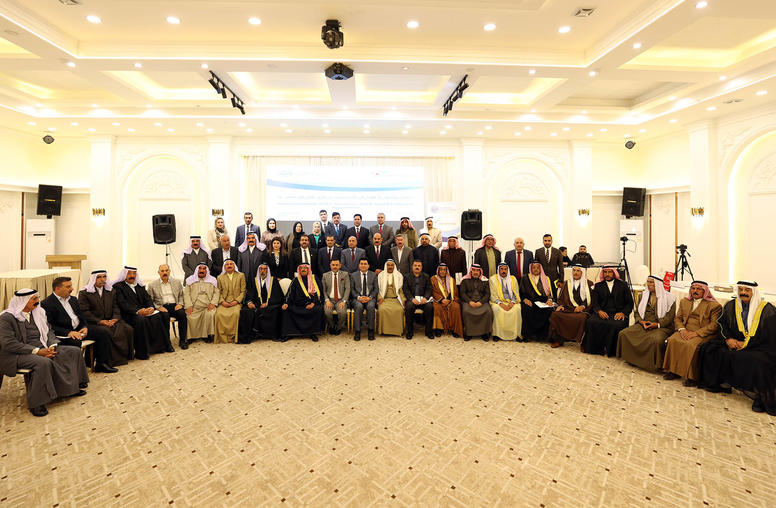Iraq Study Group Fact Sheet
1. How was the Iraq Study Group created?
The Iraq Study Group (ISG) was launched on March 15, 2006, at a meeting on Capitol Hill, Washington, D.C. It was created at the direction of a bipartisan group of members of the U.S. Congress. Representative Frank Wolf (R-VA) was the leading supporter of the group’s creation. Wolf had been calling for a “fresh eyes” assessment of the situation in Iraq since the summer of 2005. From its inception, the ISG was designed to be bipartisan, and the initiative attracted broad, bipartisan support among members of the House and Senate.
- USIP press materials about the ISG can be found here.
- Congressional press materials about the ISG can be found here.
2. Was the Bush administration involved in creating the ISG?
The Bush administration was not involved in creating the ISG, but the White House welcomed it, and provided access to people, documents, and travel to Iraq. President Bush met with the ISG members on June 14, 2006, and again on November 13, 2006, and met further with the two co-chairs. The White House respected the independence of the group.
A transcript of the June 14 ISG White House meeting with President Bush can be found here.
3. What role did United States Institute of Peace play with the ISG?
Congressman Frank Wolf, who chairs the House Appropriations Subcommittee that funds the United States Institute of Peace (USIP), asked USIP to act as the facilitating agency for the ISG, with the support of the Center for the Study of the Presidency, the Center for Strategic and International Studies and the James A. Baker III Institute for Public Policy at Rice University.
As facilitator, USIP maintained an in-house Iraq expert committee that supported the ISG principals in their work. USIP assisted the group and its members by convening expert working groups, writing briefing papers, providing analysis, and coordinating meetings of the ISG.
4. Did the ISG have a specific mandate?
The ISG was not given a statutory mandate when it was created. However, at the direction of the ISG co-chairs, its orientation was to offer a forward-looking assessment of the current and prospective situation in Iraq, including policy suggestions and advice. Specifically, ISG members focused their review of the situation in Iraq on four broad topics:
- The strategic environment in Iraq and the region;
- The security of Iraq and key challenges to enhancing security within the country;
- Political developments within Iraq following the elections and formation of the new government;
- The economy and reconstruction.
5. Who served on the ISG?
The ISG principals were a bipartisan group of senior individuals who have had distinguished careers in public service. Its co-chairs were former Secretary of State James A. Baker, III (R) and former chairman of the House International Relations Committee Lee Hamilton (D).
The other ISG members were:
- Lawrence S. Eagleburger, former U.S. Secretary of State ;
- Vernon E. Jordan, Jr., Senior Managing Director, Lazard, Freres & Co. LLC;
- Edwin Meese, III, former U.S. Attorney General;
- Sandra Day O’Connor, former U.S. Supreme Court Associate Justice;
- Leon E. Panetta, former White House Chief of Staff;
- William J. Perry, former U.S. Secretary of Defense;
- Charles S. Robb, former U.S. Senator;
- Alan K. Simpson, former U.S. Senator.
6. How was the membership chosen?
Co-chairs Baker and Hamilton were chosen by mutual agreement among the Congressional organizers, USIP, and the other supporting organizations. After being named co-chairs, Baker and Hamilton selected the remaining group members in consultation with USIP and the other supporting organizations.
7. What other experts were involved?
USIP convened expert working groups in the areas of Economy and Reconstruction; Military and Security; Political Development; and Strategic Environment. The working groups were chaired by senior USIP staff, and their membership was comprised of experts from academia, government and the private sector. The experts contributed 31 different analytical and policy papers for the study group’s review. In all, 44 such experts participated pro bono to provide advice to the study group.
- A complete list of the working group membership can be found here.
8. What outside groups and individuals did the ISG consult with during this process?
ISG principals met with many current and former high-level U.S. and Iraqi government officials in Washington, Iraq and elsewhere, including President Bush, Iraqi Prime Minister Al-Maliki, as well as military officers, foreign government officials, academics, business executives and heads of civil society organizations in the U.S. and in Iraq. The ISG members met with 171 individuals over nine months. In addition, the expert working group members met with or consulted hundreds of others.
- A comprehensive list of ISG consultations can be found here. (PDF - 56KB)
9. When did the ISG issue its report?
The ISG issued its final report on December 6, 2006.
10. What recommendations did the ISG make?
The ISG made 79 specific recommendations in its final report.
- The final report can be found here.
11. To whom was the report issued?
The ISG's final report was issued first to President Bush at the White House, then to members of Congress on Capitol Hill. It was then released to the public at a press conference the morning of December 6, 2006.
12. How many reports did the ISG issue?
The ISG issued one final report.
13. What actions were taken after the report was issued?
The ISG provided recommendations that the Bush administration and Congress can use to consider the future direction of U.S. policy regarding Iraq. Actual policy decisions, of course, can only be made by the administration and Congress.




